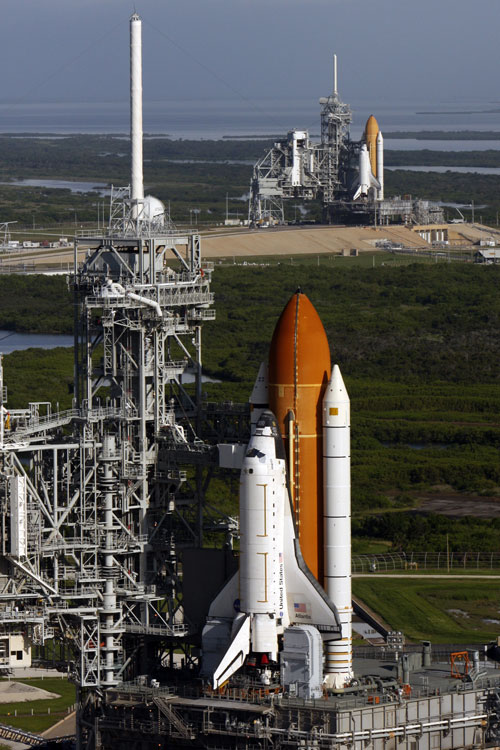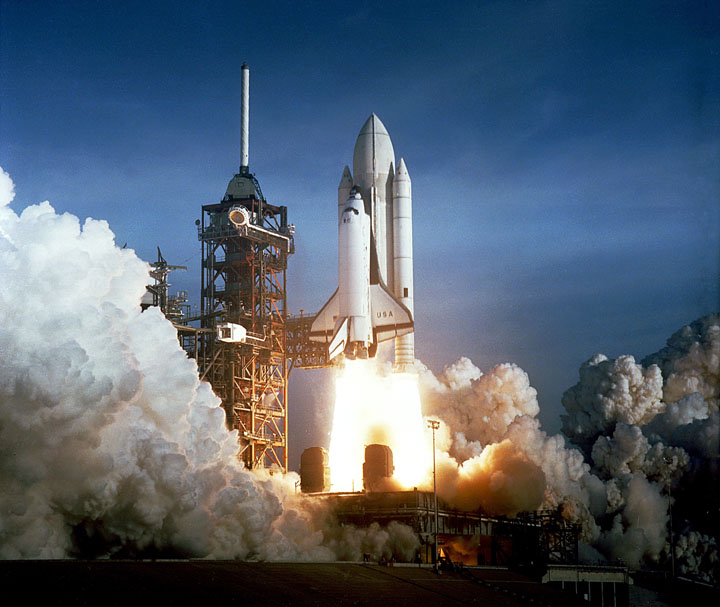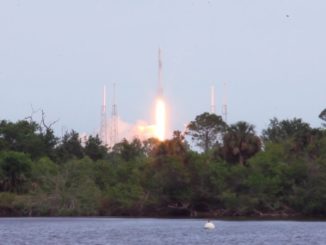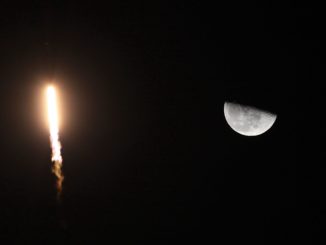America’s first space shuttle launched on this day 35 years ago as the reusable flying machine, Columbia, lifted off from Kennedy Space Center with John Young and Bob Crippen aboard.
The launch came 20 years to the day after human spaceflight began. Yuri Gagarin launched aboard Vostok 1 to become the first person to orbit the Earth in 1961.
The Space Transportation System would operate through July 2011, launching 3.5 million pounds of payload during 135 missions over 30 years with a fleet of five orbiters — Columbia, Challenger, Discovery, Atlantis and Endeavour.
A fully assembled space shuttle stack was approximately 184 feet tall with a wingspan of 78 feet. Liftoff weight was 4.5 million pounds.

The delta-winged spaceplanes featured a two-level crew module, a flight deck where the commander manually flew the landings in the front-left seat and an aft station where payloads were controlled and the 50-foot-long robotic arm was operated. The lower middeck featured the galley, toilet and sleep quarters, plus entrance to the airlock for spacewalks.
The 60-foot-long, 15-foot-wide payload bay hosted both deployable satellites ejected from support structures and others maneuvered by the robotic arm for release. Other payloads featured scientific instruments and laboratory modules that remained stationary in the bay for the duration of the flight.
The missions logged 1,334 days, 1 hour, 36 minutes, 44 seconds in flight, traveling 542,398,878 miles spanning 21,152 orbits of the Earth with 355 astronauts — 306 men and 49 women — from 16 different countries.
The youngest person was 28-year-old Sultan bin Salman bin Abdul-Aziz Al Saud on STS-51G in 1985 and the oldest was John Glenn, 77, who flew on STS-95 in 1998.
The shuttle had two launch pads at the Kennedy Space Center in Florida, making 82 flights from pad 39A and 53 from pad 39B. There were 101 daytime launches and 34 at night.

The orbiters and their propulsion systems consisting of three hydrogen-fueled main engines were fully reusable, as were the twin solid rocket boosters that delivered a combined 7.3 million pounds of thrust at liftoff. The solids would burn out and separate two minutes into flight, parachuting into the Atlantic for retrieval and reuse. An external fuel tank holding a half-million gallons of liquid hydrogen and liquid oxygen for the main engines was the only element of the shuttle system not recovered, separating from the orbiter eight-and-a-half minutes after launch on a suborbital trajectory.
Flights ranged from the shortest mission of just 2 days, 6 hours on STS-2 to the longest of 17 days, 16 hours on STS-80.
The shuttle had 37 dockings with the International Space Station and 9 to the Russian space station Mir. Ten missions were dedicated to the Department of Defense, 9 launched classified satellites and one was an unclassified research flight.
Payloads went into low-Earth orbit, highly elliptical orbit, geosynchronous orbit and escape trajectories for the space probes Magellan to Venus, Galileo to Jupiter and Ulysses to the sun.
A variety of satellites were retrieved by the orbiters for either repairs by spacewalking astronauts or trucking back to Earth. Five servicing calls were performed to refurbish and upgrade the Hubble Space Telescope.
The heaviest known payload was NASA’s Chandra X-Ray Observatory with its Inertial Upper Stage booster on STS-93 at 50,162 pounds.

Three sites were used for space shuttle landings — Kennedy Space Center in Florida, Edwards Air Force Base in California and White Sands Space Harbor in New Mexico. KSC saw 78 landings including 20 at night, Edwards saw 54 landings with six at night and White Sands was used only once. Twenty-six missions had their landings diverted from the primary site to an alternate due to weather.
No shuttle ever made an emergency Return-to-Launch-Site (RTLS) back at KSC, Transoceanic-Abort-Landing (TAL) in Africa or Europe nor an Abort-Once-Around during ascent. Only STS-51F in 1985 declared an Abort-to-Orbit after one of the main engines shut down.
The surviving orbiters are retired to public display at museums across the country. Discovery is located at the Smithsonian’s Steven F. Udvar-Hazy Center in Chantilly, Virginia, Atlantis is at the Kennedy Space Center Visitor Complex in Florida, Endeavour is at the California Science Center in Los Angeles and Enterprise, the prototype shuttle, is aboard the Intrepid Sea, Air & Space Museum in New York City.
Two deadly accidents occurred during flight that resulted in the loss of vehicle and crew. Challenger was destroyed during launch of STS-51L in 1986 due to cold weather that adversely affected an O-ring seal design in a solid rocket booster joint. Columbia disintegrated during re-entry on STS-107 in 2003 after a breach in the heat shield caused by an external tank foam impact during launch went undiscovered.
At the end of the space shuttle program, NASA said the average cost to prepare and launch a mission was approximately $775 million. The lifetime cost of the shuttle program was $113.7 billion.




